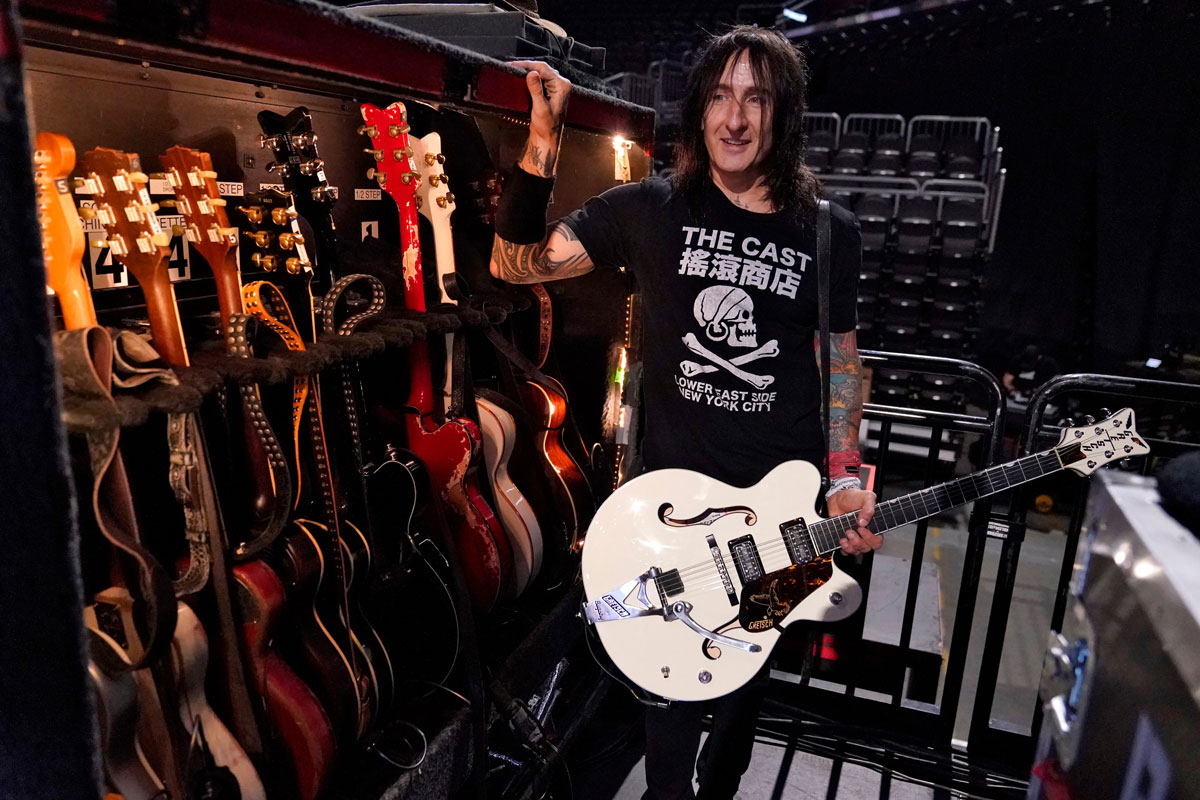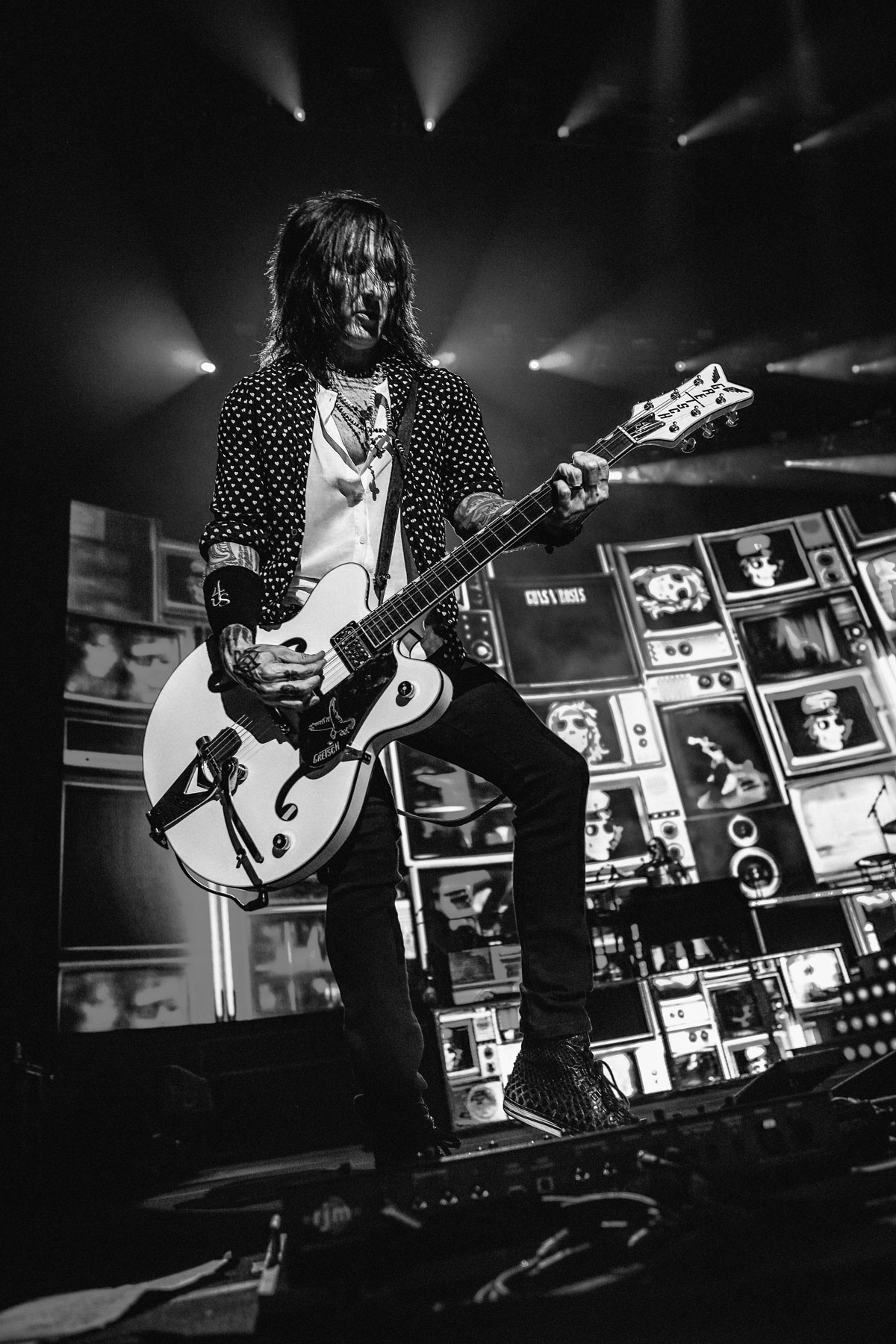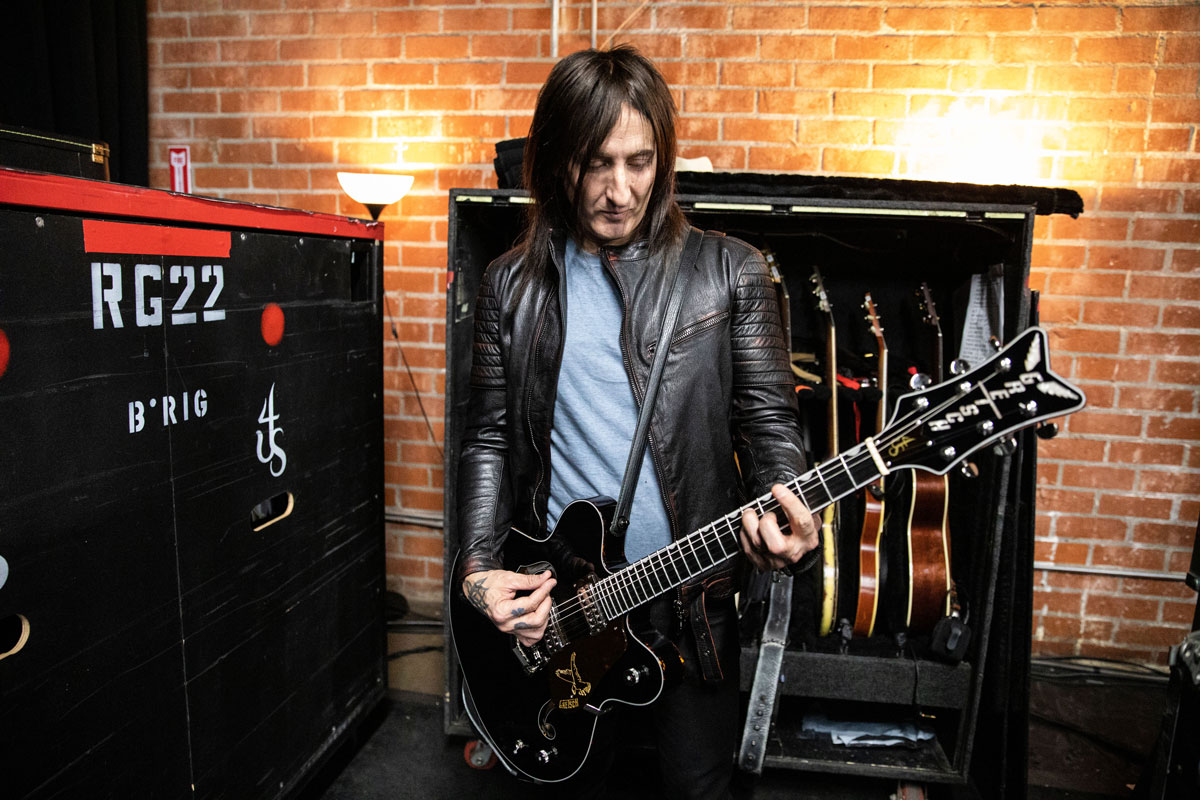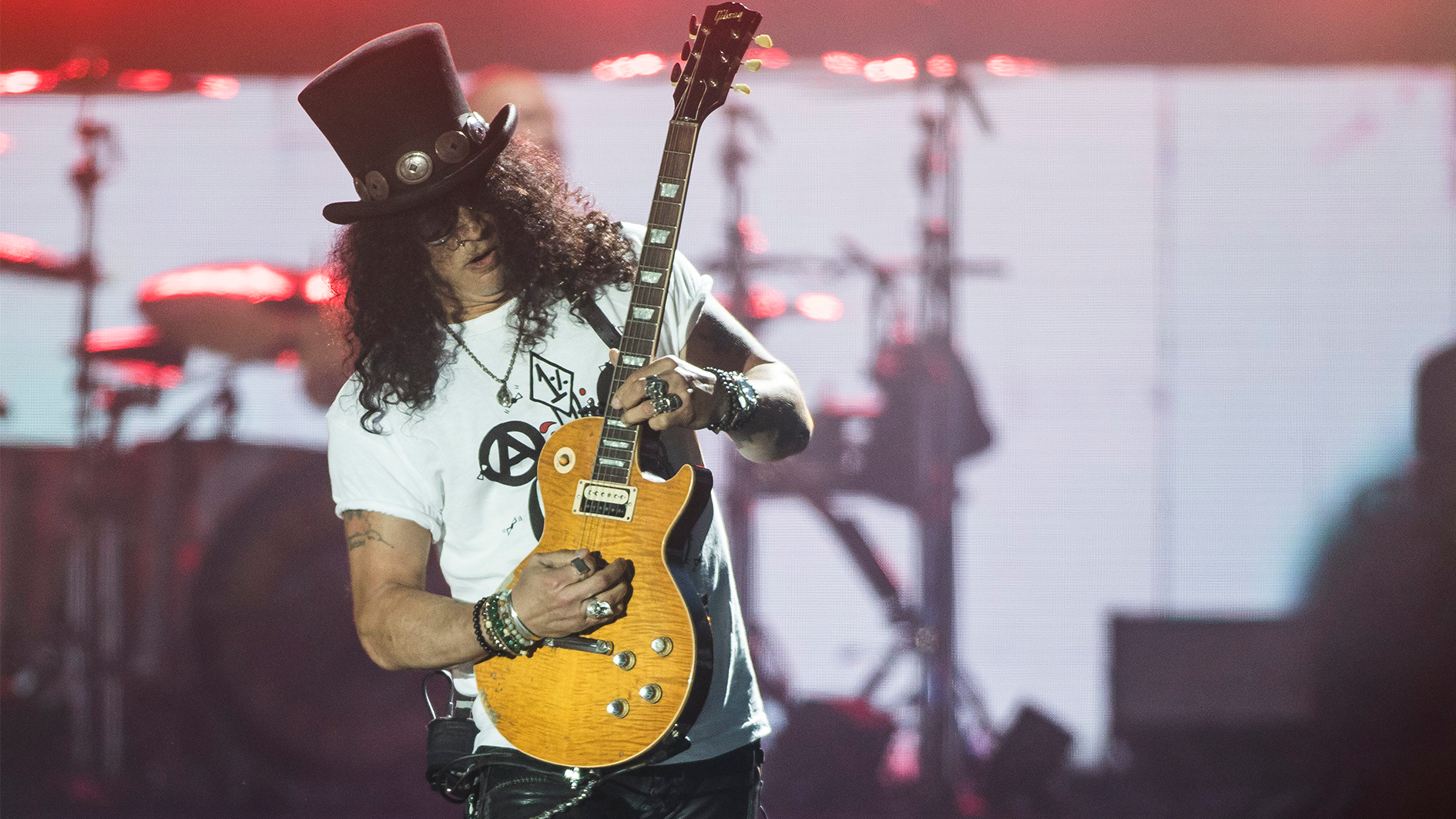Richard Fortus: “When I landed on Gretsch, it really came together. There’s a magic to that sound that fits perfectly around what Slash is doing”
The Guns N' Roses guitarist on developing two new signature models with Gretsch, his favorite amps and pedals, and the inimitable genius of his legendary co-guitarist

Richard Fortus’s rock and roll credentials are, quite frankly, astonishing. He’s been a fully fledged member of Guns N’ Roses for two decades, appearing on 2008’s Chinese Democracy and every tour since joining.
In more recent years, he’s been seen trading licks with Slash on the Not In This Lifetime reunion run, which has seen the group reverting back to their classic twin-guitar assault and making history headlining one of the highest-grossing tours of all-time.
But that’s just the tip of the iceberg. Fortus has also played in Thin Lizzy, The Psychedelic Furs, Love Spit Love and The Dead Daisies, and even worked with pop stars like Rihanna and Enrique Iglesias well outside the typical confines of rock. He’s proven time and time again to be a wonderfully tasteful and diverse guitar player, with an incredibly well-rounded approach to the instrument.
It’s something that explains a lot about his new signatures. This year sees the release of two Gretsch Falcons – a vintage white Bigsby-equipped G6636T and a black V-Stoptail-styled G6636. His aim was to create two distinct guitars for different musical situations, one to accommodate more snappy-sounding rhythmic playing and the other better suited to his stunning lead style...
“The scale lengths are different: the black one is 24.6 and the white is 25.5, which is the traditional Gretsch scale as far as Falcons go,” he explains, talking to Guitar World via a Zoom conference from his home studio.
“The reason I wanted to do that is because I like having the longer scale with the Bigsby. Initially we tried the B7, but it wasn’t working for me. Sensitivity is more important to me. That subtlety of being able to move your wrist a little to create that gentle modulation is what I love about Bigsby. Without that, it sorta defeats the purpose.
“So to accommodate the B6 we actually had to change the neck angle a bit. Gretsch were very patient and equally as tenacious in finding the correct formula. You have a bit more snap with the longer scale. It works better with the Bigsby, and the intonation is better.
Get The Pick Newsletter
All the latest guitar news, interviews, lessons, reviews, deals and more, direct to your inbox!
“But what you sacrifice is the ease of bends – obviously having a stoptail makes it more seamless. When you’re doing fast lines or soling, it’s nice to have the stoptail and shorter Gibson scale. That’s what feels comfortable to me there, which is why we ended up doing two.”
So which Guns N’ Roses tracks do you feel would best suit each instrument?
“Something like Rocket Queen would suit the shorter scale and stoptail, because Slash and I tend to go back and forth on that. There’s a lot of trading solos and bends, so that’s a track I’d pick the black one for.
“I’d pick up the white one for Mr. Brownstone because I want the Bigsby and the intonation is really important to me on that song, which doesn’t involve many bends for me. I guess that’s the criteria to decide which to use.”
We heard you’d already been using them on the new material...
“I did use them on the new EP and this whole last tour, which was great. The production models I had worked perfectly. The pickups were the main thing to dial in, so I’m really excited about them. That’s what makes this guitar unique to anything else out there. It’s completely reliant on the volume knob and treble bleed capacitor.”
With less gain, my sound fits around what Slash is doing
Do you remember getting your first Gretsch?
“I bought my first Gretsch when I was about 16 years old, which was a 1966 Tennessean. I’m a big Billy Duffy fan and I was also listening to a lot of AC/DC. I guess it was a tone I gravitated towards from an early age.
“That Tennessean was actually a George Harrison model and it’s a really cool guitar. It has the HiLo'Tron pickups which have a very distinct tone – it’s very unusual and hi-fi to my ears. I’ve always been really attracted to Gretsches because they look so awesome.
“I remember seeing Johnny Thunders and Sylvain Sylvain, that whole Dolls aesthetic. They both played Falcons at different times. What brought me back to Gretsch in terms of them being the main instruments I play on stage is when Slash and Duff came back into the band. I was trying out different guitars – I’m a big P-90 fan, and went through a bunch of things when we were rehearsing.
“When I landed on Gretsch, it really seemed to come together. There’s something about that classic higher-output humbucker on Slash’s side and then what I’m playing. It really fits together, in the same kind of way Malcolm and Angus [Young] did. There’s a magic to that sound. With less gain, my sound fits around what Slash is doing.”
You must own a fair few Gretsch guitars. Tell us about your favorites in the collection...
“The two that I use all the time that aren’t my signatures are my 1958 6120 and my 1957 Duo Jet. Those are the best-sounding ones, as far as my vintage ones go. I’ve spent a lot of time going back and forth comparing my guitars and those are the go-tos for that vintage Gretsch. I don’t play those live, though. They don’t hold up well on the road…”

So when did you start talking to the company about a signature model?
“Originally I wanted to do a center-block, shallower-body instrument that I could play all night and solo on, as well as use for rhythm. I wanted that screw center block. I approached Gretsch about it saying, ‘Why don’t you guys do a double cut like this?’ And as we started talking they felt it sounded like a signature model. So I was like, ‘Great, let’s do it!’ That's what I wanted out of a Gretsch... a guitar I could use all night.
“We’ve been developing them for over two years. When I got the first prototype, I realized that the pickups I use in my regular full-hollow Falcons, which are made by Arcane pickups, didn’t really work in the center-block models. Everything became really dark and muddy-sounding. It didn’t have that Gretsch chime, which I was really missing. So we had to start over again and rethink the pickups.”
And how exactly did you get around that?
“What we came up with was unique and very much a hybrid of a vintage Filter'Tron and a vintage PAF. To me, that’s the heart of the guitar and what makes it so special. John Gaudesi from Gretsch actually brought a pickup winder into our rehearsal space. We had four prototypes in rotation and we’d get them close and then take a little top-end off, then try them out again. It took quite a while! They were very patient with me, dialing everything in.
We were listening through our in-ears and our front-of-house guy was sat in a control room listening through reference monitors. Everything was under a microscope, which allowed us to focus on the details
“That’s what made it such a great collaboration – it was a huge learning experience and very eye-opening in terms of how to dial in pickups. I’ve always spent a lot of time with different guitars trying different pickups to find what works and how to get the tones I wanted. And different guitars require different pickups.
“Having the ability to do what we did was incredible. We were listening through our in-ears and our front-of-house guy was sat in a control room listening through reference monitors. Everything was under a microscope, which allowed us to focus on the details.”
Do you still run your guitars into two single-channel amps – your signature Voodoo R4 and a Supro Black Magick combo?
“Yeah, I hit those two amps together and they’re both single channel, so I get my clean sound by rolling my volume back. What’s cool about these guitars is that they get clean around two, you back it down and get this beautiful sparkle.
“Bring it up to six or eight and that’s your classic Filter'Tron chime, with tons of low-end, and it sounds super-heavy. When you bring the volume wide open, that’s when the top rolls off and smooths out – it has that warm PAF quality to it, while still being really detailed. It’s a tone that really sings and it’s really magical.”

We heard the Voodoo was loosely based on your Jose Arredondo-modded Marshall, which you’d bought from Mick Mars...
“Trace Davis from Voodoo meticulously cloned that amp. I have another ‘73 100-Watt from the same month that he also used. It was dead-on and then he took it further. But that was just the starting point for the Voodoos. We tweaked and tweaked forever because that’s what we do. So it ended up becoming very much its own thing, but it started as a clone of the Mick Mars Jose mod!”
What pedals are blowing your mind right now – we’d noticed you’d been trying out stuff by Pedal Pawn, Drybell and Dawner Prince...
“I’m absolutely using those Pedal Pawn ones a lot. They’re incredible! If I’m at home playing a Strat, I’m using both of those boxes, the Fuzz and the Texan Tang. You get a real glassy sound when you turn your volume down on the fuzz. I’ve also been using their Uni-Vibe pedal, which is called the Gypsy Vibe, and it’s the best I’ve ever heard.
“The Drybell Unit 67 is a great compressor/boost and I have that in my A rig right now. Dawner Prince make some amazing stuff, too – that Boonar delay is one great-sounding pedal. There’s also the R2R stuff which I really like, and then there’s the Isle of Tone… that fuzz pedal is so good.
Slash walks out to play a solo in front of a stadium full of people and he has no idea what he’s going to do. He’s just so in the moment
“I’ve recently switched out my Sacred Cow overdrive for the Jeff Beck version of the J. Rockett Archer. I’m a big Klon fan and the Archer does it impeccably. I got my first Klon when I joined Guns, so about 20 years ago. I was running that into my old Marshall when I first started in the band.
“Then there’s the Joe Gore Cult Fuzz, which is fantastic. And I’ve used the Lovepedal Eternity for extra drive at points. It’s very transparent, and has a glass knob which is a treble booster circuit. So you can fade that into the sound subtly and it really adds this cool element that makes your tone very articulate. It’s very different to what the Klon does, in that sense.”
But it’s not all boutique stuff – you still use pedals like the Arion Stereo Chorus, the DOD Envelope Filter and an MXR Phase 90...
“That phaser is actually one of the reissue ones they did with the NOS parts. It was a limited run and man, they sound exactly like my old one! But yeah, I used the DOD and the Arion on Chinese Democracy, so that’s why I keep them in the rig. And, to be honest, both of those pedals are very unique – they both do something that nothing else does. I’ve tried a ton of stuff that does similar things but it’s just not the same.”

What’s been your favorite song on the setlist during this reunion run?
“When we were last in Europe we were playing [Pink Floyd’s] Wish You Were Here, which ended up being one of my favorite moments in the set. That just came about because Axl broke his foot on the first show of the tour. So he was in the chair and we were at soundcheck preparing for the second show. He wanted us to fill some time for him to get to the piano for November Rain and come up with some musical thing for that point in the set.
“Slash looked at me and was like, ‘What do you want to do?’ And I was like, ‘I don’t know!’ so then he asked if I knew Wish You Were Here and I said yes. He just started playing it and we all came in together. We just did it once at soundcheck and the crew – who are the most jaded people ever [laughs] – just stopped and applauded when we finished. Because it was like this magical thing that happened… that’s what music is, a magical conversation. We liked how it sounded so we kept it for the rest of the tour.”
Some of those more improvised moments end up being a highlight of the set for the crowd, too!
“It was so much fun because Slash was playing completely different every time. He doesn’t repeat himself. That’s why he is a legend. As a guitar player, you tend to fall into your ruts – you know what works for your solos and how to build them when you play them every night. But Slash doesn’t do that, in the same way Hendrix never did. You’d listen to four different bootlegs from the same tour and they’d all be completely different. But Slash always plays Slash… he’s doing his thing.
“That’s what a legend is and I love that. Slash walks out to play a solo in front of a stadium full of people and he has no idea what he’s going to do. He’s just so in the moment, he starts playing and what comes out comes out. It’s absolutely amazing to bear witness to. I get to watch that every night.
“And some nights I’m like, ‘God damn, how does he do this?’ It’s so inspiring. When we have that moment of back and forth during that song it’s great. We push each other to do something different – or at least he pushes me – to not fall into a rut and keep evolving and stretching out. That was always a great moment in the set.”

There’s a realness to improvising like that – as any Jeff Beck fan will tell you...
“That’s one thing I love about how this band and how Guns works. It’s very much about playing in the moment. And yeah, Jeff Beck’s the exact same way. I’ve seen times when he’s not been great, but then when he is, he’s the best... ever!
“That’s why Jeff Beck is the ultimate player in my opinion. That whammy bar is part of his voice, it almost sounds like he’s playing slide. He’s the only one of those original English blues guitarists who got better and better. He literally never stopped. Every record he’s released has taken it to another level. I just don’t know how he does it.”
With you and Slash up there, it definitely feels like two guitars is working better than three…
“Yeah, there’s no way three guitar players would work in this band right now. Three guitars is actually very difficult to do. Buckethead did it really well, I think. It worked with me, him and Robin Finck. You have to leave space for each other to create that big dynamic. Buckethead really understood that because he’s very musical. And I’m a big fan of Robin’s, he’s incredible, too… both of them knew it had to fit together like a puzzle.”
- For more information on Richard Fortus's signature Falcons, head to Gretsch Guitars.
Amit has been writing for titles like Total Guitar, MusicRadar and Guitar World for over a decade and counts Richie Kotzen, Guthrie Govan and Jeff Beck among his primary influences as a guitar player. He's worked for magazines like Kerrang!, Metal Hammer, Classic Rock, Prog, Record Collector, Planet Rock, Rhythm and Bass Player, as well as newspapers like Metro and The Independent, interviewing everyone from Ozzy Osbourne and Lemmy to Slash and Jimmy Page, and once even traded solos with a member of Slayer on a track released internationally. As a session guitarist, he's played alongside members of Judas Priest and Uriah Heep in London ensemble Metalworks, as well as handled lead guitars for legends like Glen Matlock (Sex Pistols, The Faces) and Stu Hamm (Steve Vai, Joe Satriani, G3).
“His songs are timeless, you can’t tell if they were written in the 1400s or now”: Michael Hurley, guitarist and singer/songwriter known as the ‘Godfather of freak folk,’ dies at 83
“The future is pretty bright”: Norman's Rare Guitars has unearthed another future blues great – and the 15-year-old guitar star has already jammed with Michael Lemmo










